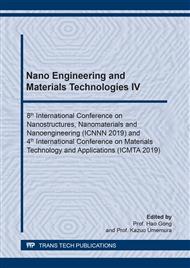p.67
p.73
p.81
p.86
p.91
p.96
p.101
p.106
p.111
Preparation and Characterization of a New Absorbent Pad from Rice Starch
Abstract:
Thisresearch was aimed to studying absorbent pad of adhesive bandage. The absorbent pad made from rice starch composite. This material used for healingprocessofwounds.One component of adhesive bandage is the part contact wound (absorbent pad) that obtained rice starch-based sponge for hemostatic and mixed with povidone-iodine for antibacteria. In this study, we prepared a new absorbent pad from rice starch by lyophilization and characterized by X-ray diffraction (XRD), scanning electron microscopy (SEM), water absortion, Fourier transform infrared spectroscopy (FTIR), and disk diffusion method. The rice strach content of this pad is up to 94 wt%. The diameter of the porous pad was found to be in the range of 10-100 mm. Water absorption of this pad was 6 times of dry weight. The addition of povidone iodine showed good antibiotic resistant microorganism of the rice sponge.
Info:
Periodical:
Pages:
91-95
Citation:
Online since:
May 2020
Keywords:
Price:
Сopyright:
© 2020 Trans Tech Publications Ltd. All Rights Reserved
Share:
Citation:


